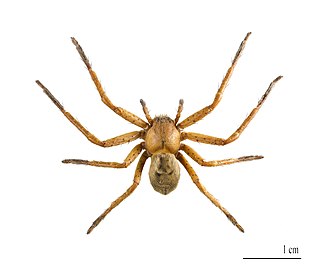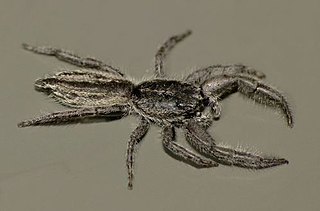
Huntsman spiders, members of the family Sparassidae, are known by this name because of their speed and mode of hunting. They are also called giant crab spiders because of their size and appearance. Larger species sometimes are referred to as wood spiders, because of their preference for woody places. In southern Africa the genus Palystes are known as rain spiders or lizard-eating spiders. Commonly they are confused with baboon spiders from the Mygalomorphae infraorder, which are not closely related.

Cephalocereus senilis, the old man cactus, is a species of cactus native to Guanajuato and Hidalgo in eastern Mexico. It is threatened in the wild, but widespread propagation and popularity in cultivation have reduced the demand on wild populations.
Benoy Krishna Tikader (1928-1994) was an Indian arachnologist and zoologist and a leading expert on Indian spiders in his time. He worked in the Zoological Survey of India and published the Handbook of Indian Spiders in 1987. The book describes 40 families and 1066 species of India, many of which were described by Tikader himself. The handbook is a guide to all arachnids including scorpions, and not just spiders. He was also a popular scientific author in his native language of Bengali, and was the author of Banglar Makorsha for the layman.
Gambusia senilis, the blotched gambusia, is a species of fish in the family Poeciliidae found in Mexico, where it is called guayacon pinto, and formerly in the Devil's River in the Rio Grande basin in Texas. The Texas population was extirpated following the construction of the Amistad Dam.
Olios lepidus is a species of huntsman spider, found in Brazil.

Olios argelasius is a species of huntsman spider found in the Mediterranean Basin. It was first described by Charles Athanase Walckenaer in 1805.

Olios is the largest genus of huntsman spiders, containing 250 species. They are found throughout the world, with most species occurring in hot countries. The genus was first described by Charles Athanase Walckenaer in 1837.
Olios suavis is a spider species found in Cyprus, Israel and Egypt.
Olios ceylonicus is a species of spider of the genus Olios. It is endemic to Sri Lanka. It is part of the huntsman spider family Sparassidae.
Olios greeni, is a species of spider of the genus Olios. It is endemic to Sri Lanka.
Olios hirtus, is a species of spider of the genus Olios. It is endemic to Sri Lanka.

Olios lamarcki, is a species of spider of the genus Olios. It is found in Madagascar to Sri Lanka and India. The subspecies O. lamarcki taprobanicus is endemic to Sri Lanka.

Olios milleti, is a species of spider of the genus Olios. It is native to India and Sri Lanka. According to SpiderID, Olios milleti is most often sighted outdoors during the month of February.

Curicaberis is a genus of huntsman spiders that was first described by C. A. Rheims in 2015.

Olios giganteus is a species of giant crab spider in the family Sparassidae. It is found in the United States and Mexico.

Holoplatys apressus is a species of jumping spider endemic to New Zealand.








